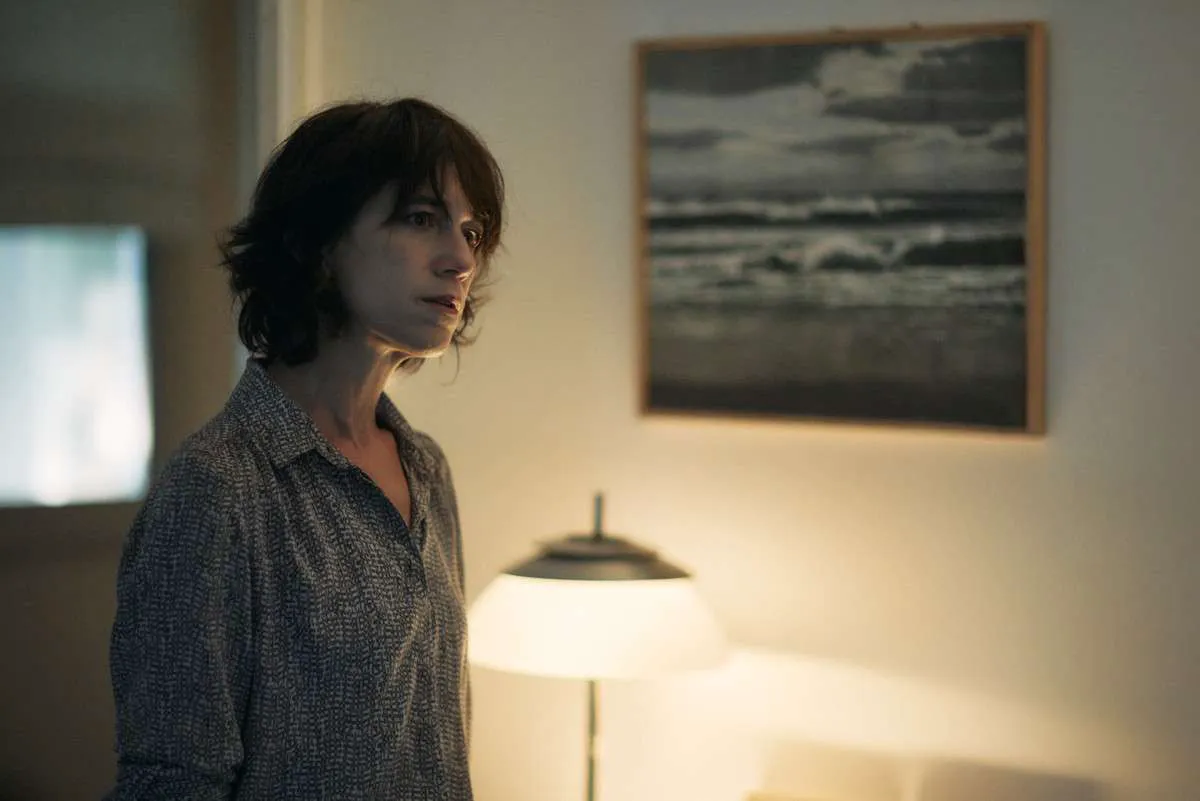The Enigmatic Case of “Belle’s Mystery”
Pierre (Guillaume Canet), an unassuming mathematics teacher, lives a quiet life in a provincial French town with his wife, Cléa (Charlotte Gainsbourg), who runs a small optics shop. Their tranquil existence is shattered when they find themselves at the center of a media frenzy following a tragic event: Belle, the daughter of Cléa’s best friend, is murdered in their home one night. As the only person present at the time of death, Pierre instantly becomes both a witness and the prime suspect.

Charlotte Gainsbourg as Cléa in a still from “Belle’s Mystery”
Director Benoît Jacquot updates Georges Simenon’s novel “Belle’s Death” from the 1950s to a contemporary setting, highlighting how the rapid spread of information can lead to public condemnation long before any legal judgment. Pierre quickly becomes the perfect scapegoat: introverted, impassive, and socially awkward, he prefers to keep to himself. His demeanor, silence, and lack of emotional displays don’t elicit sympathy; instead, they breed suspicion. As the film progresses, Jacquot explores the central theme: how should an innocent person behave when accused of a crime? And what about the presumption of innocence?
A Society Quick to Judge
Jacquot paints a portrait of a society where rumors, accusatory remarks from friends, hostility from colleagues, and crude graffiti speak louder than official investigations. Even Pierre’s students are quick to condemn him, finding him perpetually strange. The collective ostracization of the already isolated Pierre soon becomes routine. After all, if he isn’t the killer, then who is?

Charlotte Gainsbourg as Cléa in a still from “Belle’s Mystery”
Pierre spends much of his time in a sparsely furnished basement with barred windows. A table against the wall, a record player, a large chalkboard, and numerous notebooks fill the cold, impersonal space, hardly conducive to comfort. But Pierre finds solace there. He enjoys the silence, observing a charming, nude neighbor through the window, and contemplating probability theory.
The Paradox of Freedom in Confinement
Paradoxically, Pierre feels most free in this confinement. He avoids crowds, and the murder accusation only intensifies his desire to hide. Gradually, external pressures encroach on his personal life, eroding his already fragile relationships. Cléa repeatedly insists she “will never leave Pierre,” even when no one asks her to, yet she impulsively cheats on him with a former lover. It seems a distance has long existed between husband and wife, their life together resembling a decorative structure maintained out of politeness and fear of change.
Mathematics as Metaphor
Mathematics is not just Pierre’s profession but also a metaphor for the film’s logic. The theory of probability, which he studies so intently, permeates the narrative. What is the probability of his guilt? And if the probability is high, is that enough to condemn him? Do we live in a world of truth or a world of interpretations? Even Pierre’s silence can be interpreted in different ways: is it an admission of guilt or a resistance to a world unworthy of explanation? The music adds a touch of irony: during particularly tense moments, an unsettling melody plays, initially mistaken for background music, but later revealed to be diegetic – Pierre himself plays the music in his car or at home. Jacquot seems to emphasize that Pierre creates his own atmosphere, voluntarily assuming the role of the villain.

Charlotte Gainsbourg as Cléa in a still from “Belle’s Mystery”
An Anti-Detective Story
Structurally, the film resembles Justine Triet’s “Anatomy of a Fall,” moving away from the classic detective story focused on solving the crime and instead concentrating on the psychological landscape. The investigation stalls: there are no new clues, no real alternative suspects besides Pierre. But instead of boredom, a paradoxical sense of mounting tension arises. Precisely because there is no progress, the characters obsessively revisit past events and possible futures. The film doesn’t seem to need a conclusive ending, as it’s not a detective story but rather an anti-detective story – it’s not about solving a crime but about examining the society in which the characters live.
Jacquot also touches on the theme of male depression, reminiscent of Michel Franco’s “Sundown.” Interestingly, Charlotte Gainsbourg played a close relative of the protagonist in that film as well. However, in “Belle’s Mystery,” one of the most expressive actresses of her generation is unable to fully shine due to gaps in the script. Her character remains a shadow, more of a function than a personality. The blurring of the female figure is particularly noticeable against the backdrop of Pierre, whose character seems meticulously crafted.
“Belle’s Mystery” is unlikely to please fans of fast-paced plots but will surely interest those willing to contemplate guilt as a philosophical category. When does a person become a criminal in the eyes of society – at the moment of the act or much earlier, when their behavior deviates from the “norm”?